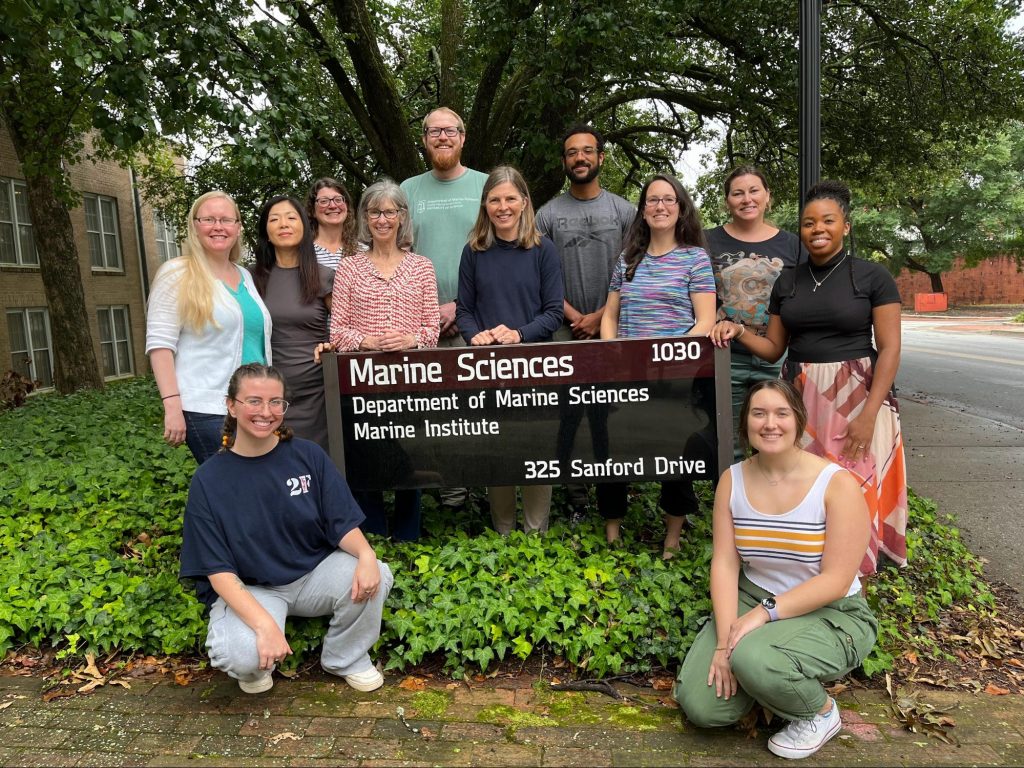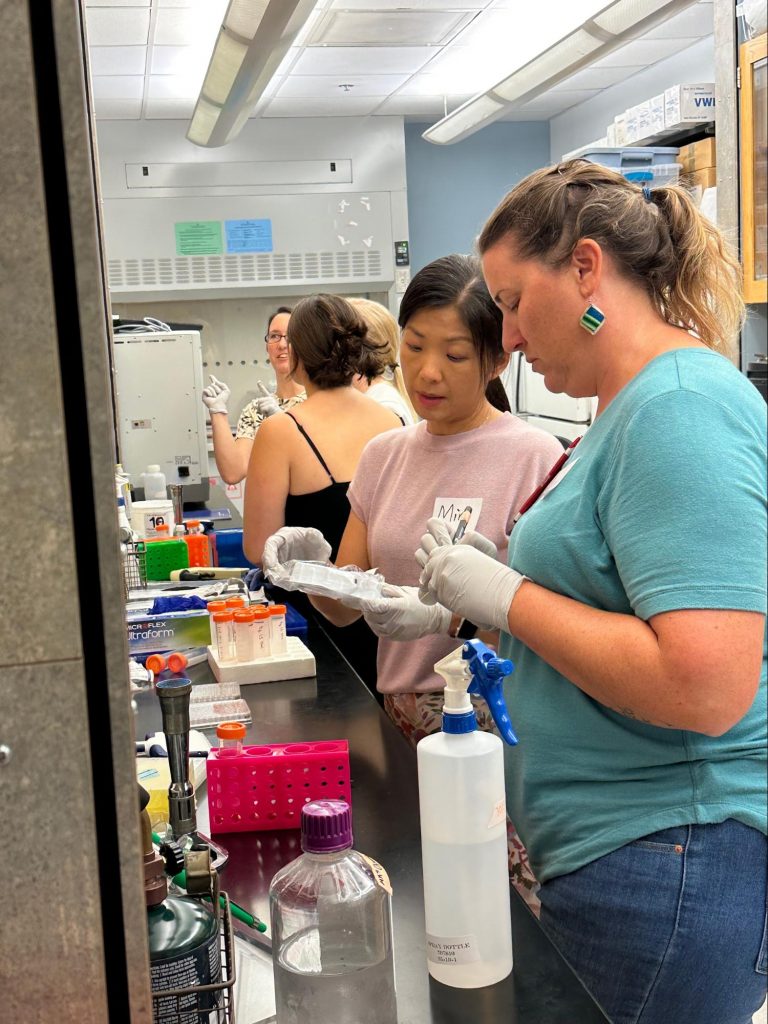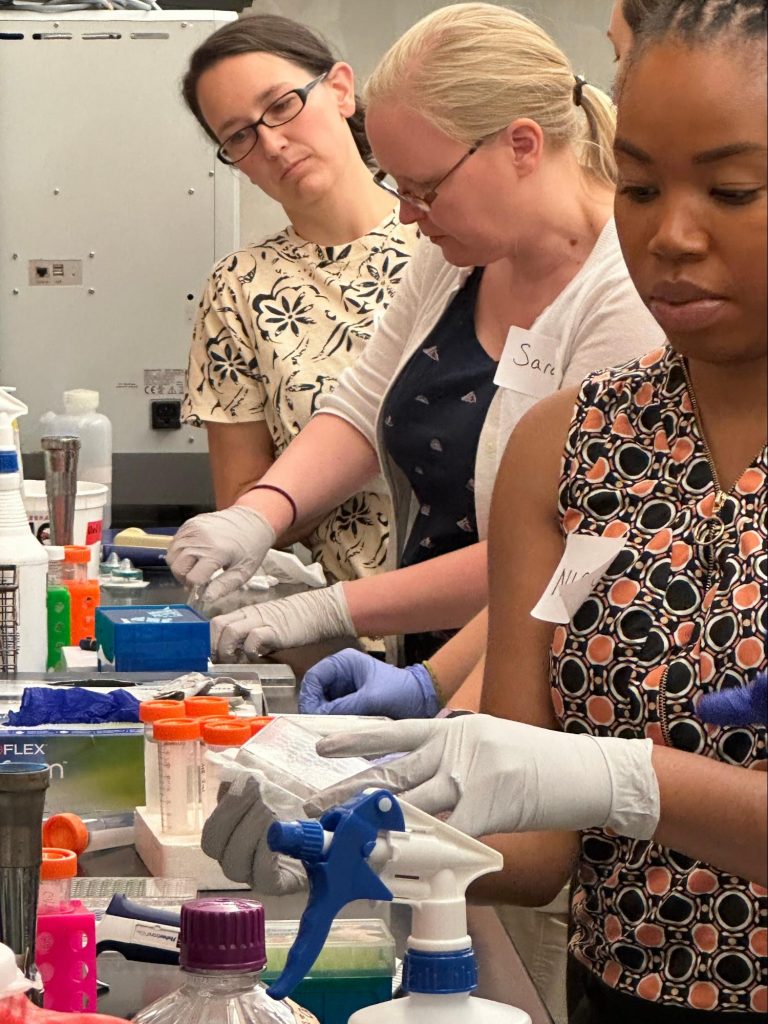A CURE for Ocean Carbon Cycling
C-CoMP recently hosted a team of teaching-intensive university faculty to collaborate on the design of a new Course-based Undergraduate Research Experience, the Ocean Genes CURE. This introductory-level CURE[1] is grounded in research from the Moran lab (opens in new window) at the University of Georgia.

The group wraps up the Ocean Genes planning meeting on the University of Georgia campus.
Associate Professor of Biosciences, Sara Anderson, and Associate Professor of Chemistry & Biochemistry, Michelle Tigges, from Minnesota State University Moorhead, Assistant Professor of Biology and Environmental Science, Flor Breitman, from Auburn University at Montgomery, and Senior Lecturer of Biology, Min Zhong, from Auburn University were selected to collaborate as instructor-partners on the Ocean Genes CURE because of their experience teaching CUREs in the past and their potential to engage a broad and diverse group of students in research at their respective universities. C-CoMP Postdoctoral Fellow Nicole Lynn-Bell from the University of Florida joined the group to become familiar with CURE design and instruction, which she plans to apply in her own future teaching. They visited the Moran lab in early August to familiarize themselves with the research protocols and discuss how to tailor the CURE to their students and situations. For example, Zhong will implement the CURE in an introductory undergraduate biology course. “My students will not have had much lab experience at all,” she said, “so they will need a lot of practice with basic lab techniques before working with bacterial samples.” Anderson and Tigges will be working with more advanced students. These students “need to be able to individualize their work within the CURE,” said Anderson. Tigges added, “It is important that they are able to take ownership of their part in the research.”

Min and Flor discuss how to help students learn CURE protocols.
The Moran lab and others have studied microbes that live near the surface of the ocean and have determined that particular microbes, such as the bacterium Rugeria pomeroyi, have genes that appear to code for transporter proteins that make it possible for microbes to take up carbon-rich compounds in surrounding seawater. Many of these compounds (metabolites) are products of the chemical processes essential for life of the other organisms that coexist with bacteria. Metabolite uptake by microbes is critical to understand because it reflects how much carbon is cycled through the surface ocean before being released back into the atmosphere, ultimately affecting global warming. Little is known about what metabolites microbes take up and which proteins these microbes use in the process. Students in the Ocean Genes CURE will work to address this question in the 2023-2024 academic year. They will develop their research skills while testing whether different versions of Rugeria pomeroyi, each with a specific transporter gene disabled, can take up a test metabolite. The students will be looking for strains that can no longer grow, since that finding indicates that the disabled gene is the one responsible for bringing the metabolite into the cell. Students will then report their findings back to the Moran lab, contributing to growing knowledge of bacterial proteins that run the ocean carbon cycle.
The Ocean Genes CURE has been in development for several months in C-CoMP. Professor Mary Ann Moran, graduate students William “Shep” Schroer and McKenzie Powers, and recent PhD graduate Jeremy Schreier did the initial development of the research protocols in the Moran lab. Then in spring 2023, the Moran lab mentored Dillon Doomstorm, Taylor English, Julia Jacob, and Madeline Shepard, a team of University of Georgia undergraduate researchers, in testing and refining the protocols to make them more user-friendly. C-CoMP Education Coordinator Victoria Centurino, Career Development Coordinator Erin Dolan, and University of Georgia postdoctoral researcher Mariel Pfeifer collaborated in CURE planning, bringing expertise in instructional design, teaching and learning research, and educational assessment. In parallel, Zhong also pilot-tested the protocols in spring 2023 at Auburn University, adjusting them to be more scalable and classroom-friendly and providing feedback to the Moran lab to improve technical aspects of the CURE.

Michelle, Sara, and Nicole try CURE protocols themselves.
The Ocean Genes CURE is part of C-CoMP’s efforts to broaden and diversify access to research education and careers in the ocean sciences. C-CoMP will share updates from students in the Ocean Genes CURE about how their experiments are advancing knowledge of the ocean. C-CoMP will also share instructional materials and assessment results from the teachers of the Ocean Genes CURE, so others can adapt elements of the CURE for use in their own research and teaching. Stay tuned!

Shep, Madeline, and Min examine optical density results.
Post and photos courtesy of the Ocean Genes CURE Team.
[1] To learn more about CURE instruction, visit CUREnet (opens in new window), a National Science Foundation-funded network of people and programs working to broaden access to undergraduate research.
